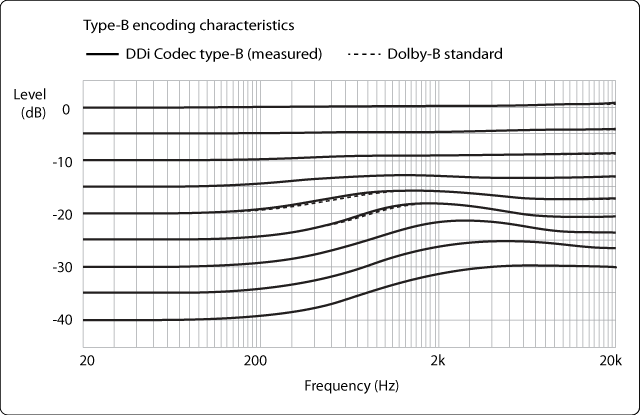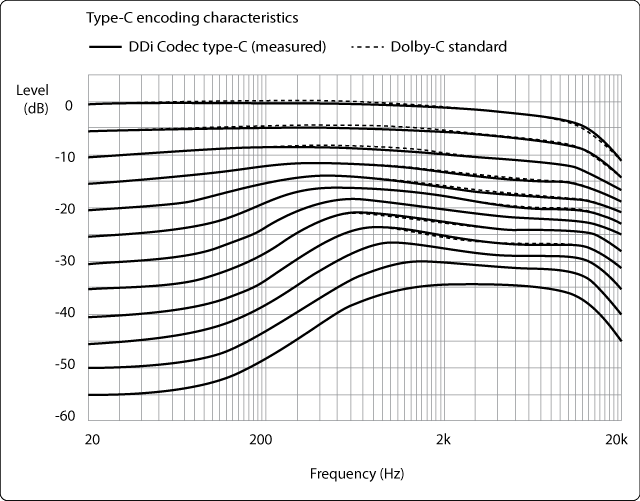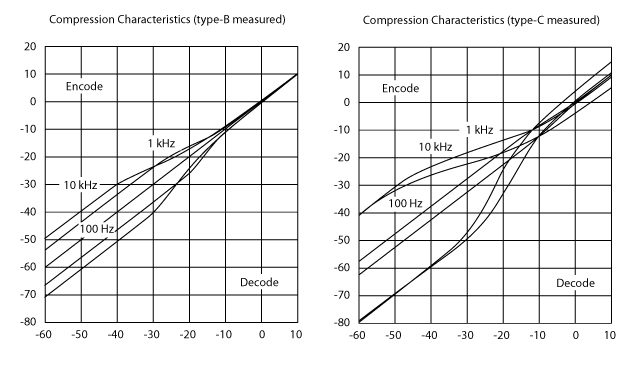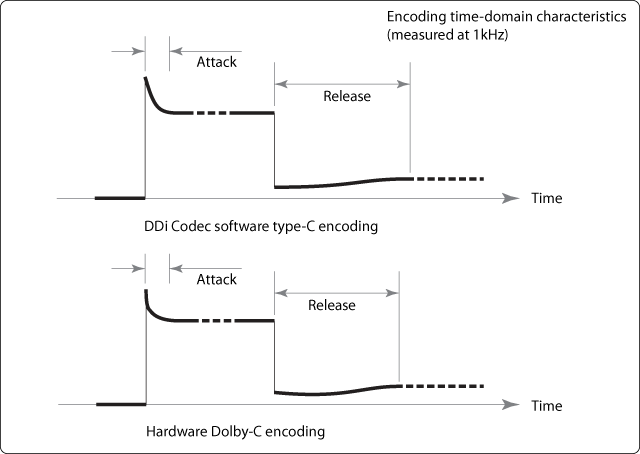Software Dolby-B|C Compatible Compander |
|||||||||||||||||
|
|||||||||||||||||
| DDi Codec is a precise digital emulation of the classic Dolby-B/C noise reduction system for analog audio tape. It is the world's first dedicated software for decoding or encoding Dolby-C formatted audio in digital domain, along with full backward compatibility with Dolby-B. Powered by the proprietary DSP engine, the decoding/encoding can be performed in realtime, which allows for instant processing, monitoring and fine-tuning. | |||||||||||||||||
|
|||||||||||||||||
 |
|||||||||||||||||
Deeper optimal result can be achieved by using the fine-tuning tools that come with the software, as specified below:
DDi Codec is a stand-alone GUI app without relying on any DAW host. It allows the computer to perform as a outboard Dolby-B/C NR unit in one of the following four scenarios:
Currently supported audio file formats are: A VST plugin is also available after the app has been installed. However, it is currently in experimantal stage and requires the full application being installed on the same computer. Minimum System Requirements: How to Install: |
|||||||||||||||||
| Audio Demo #1 (Symphony) Audio Demo #2 (Electronica) Audio Demo #3 (Vocal) |
|||||||||||||||||
Why It Matters?Some valuable audio contents are only available on specific media of their era, for example, cassette tapes in '70s ~ '90s. As the media getting obsoleted, the contents deserve extended live in new (digital) age and being appreciated via contemporary media. When being digitized, an audio tape with Dolby-B/C encoded content comes with a great potential of lower noise — if it can be decoded properly. But the reality often goes to the opposite due to the risk of Dolby-B/C tracking errors (aka: mistracking). At least three factors may cause the unexpected errors: (1) poor condition of either recorder or player or both; (2) tape degradation over time; and 3) inconsistencies among different Dolby-B/C implementations. People who are not fully aware of or not properly equipped to deal with the errors may suffer inferior results, or even give up. Fortunately, Dolby-B/C mistracking is easily audible to human ears — it doesn't require lab instruments to identify. It typically manifests as muffled sound after being decoded. However, fixing the problem is another story, which is much harder because almost all built-in Dolby-B/C systems were not adjustable by users. In other words, they were not designed flexible enough for processing off-standard inputs. So, in order to properly restore the original audio, an user-adjustable Dolby-B/C decoder would be helpful, but such an adjustable decoder was hardly available in the real world for decades. Many people do believe that Dolby-B/C decoding can be done in the digital domain. This is true but not because digital is any good at implementing Dolby-B/C system. Actually, Dolby-B/C system is a rather unique analog audio companding system which is very challenging to emulate in digital domain by DSP algorithm. The long absence of such a dedicated algorithm already spoke for the challenge. But once it is possible, the benefit is also outstanding because of the way a computer works. Mitigating Dolby-B/C tracking errors is not a one-shot deal. It is a trial-and-error decoding workflow which replies heavily on user's hearing feedback. A computer with modern DSP engine and graphic user interface (GUI) is an ideal platform that allows the job being done in an interactive, progressive and cost-efficient manner. |
|||||||||||||||||
What quality can be expected from DDi Codec software vs. analog Dolby-B/C hardware?Analog hardware was the native form of Dolby-B/C system. As of today, using analog Dolby-B/C hardware is still the best choice in theory. However, no new analog Dolby-B/C hardware is in production today. In fact, vast majority of the analog Dolby-B/C units found today are decades old and missing regular maintenance as required. They might drift out of the specification more than one can anticipate, causing Dolby mis-tracking and dull sound. The hardware here refers to tape recorders/players with built-in Dolby-B/C processor and external (outboard) Dolby-B/C analog companding units. Yes, it is possible to restore an aged Dolby-B/C hardware unit back to its specification, although it requires qualified service, expertise and price. But this is only one side of the coin. Mistracking error can still occur even with a well calibrated Dolby-B/C hardware unit when used for decoding. The tapes are the other side of the coin. Magnetic signal on a given tape may degrade over time, or it was simply encoded by an off calibration encoder in the first place. Thus, the Dolby-B/C encoded audio on a given tape may already be off standard before decoding. So, a standard complaint decoder can no longer guarantee an optimal result. It becomes a common feature request for a decoder to be able to compensate possible errors as much as possible at the end of the entire chain. This was hardly viable for a typical analog Dolby-B/C hardware which was not flexible by design. Interchangeability is another issue found among different hardware implementations of Dolby-B/C system, which was largely overlooked. Dolby Labs had licensed various manufactures to implement Dolby-B/C patents in various practical forms. Since the original Dolby-B/C prototype was given by discrete circuits, almost all the manufactures had foreseen the need to embody the system in low-cost integrated circuits. However, the original discrete circuits were based on mixed types of semiconductor, which was rather challenging to be exactly imitated with a single micro chip (at that time). Creative workarounds and progressive improvements were the common R&D footprints throughout the evolution of Dolby NR ICs. This inevitably introduced cross-generation and cross-manufacture(brand) inconsistencies, although they all aimed to closely matching the same root standard. Consequently, devices that used different Dolby-B/C ICs made in different years by different manufactures inherited such inconsistencies and presented mistracking errors when cross-processing Dolby-B/C formatted audio. This type of mistracking is non-serviceable because it can not be completely eliminated by after market re-calibration. In other words, calibration on single point at 0dB may not kill all the errors on other levels. Since digital age, there seemed to be a new easy solution — retooling Dolby-B/C system in software. While the wish is fantastic, the fact is not as easy as it sounded. Dolby-B/C system has very unique characteristics of its own, which is not found in any conventional DSP library in general. Attempting to simulate Dolby-B/C by just customizing a linear or parametric EQ plugin is a simplistic, inaccurate and amateurish idea. Design of a perfect software Dolby-B/C codec relies on exact algorithmic transformation of the original analog Dolby-B/C system, including the specific filter network topology and the JFET-based variable shunt, along with the challenge to transform the instantaneous non-linear feedback loop into a discrete-time based algorithm. Obstructed by these challenges, the demand of a software Dolby-B/C codec has never been met for decades from the beginning of digital age. Some former efforts attempted to work around these challenges by using feedforward instead of feedback, which compromised sound quality and computation efficiency because it required up-sampling and then down-sampling the audio so to reduce the predictive errors. Other attempts used fixed-band side chain with variable gain instead of sliding-band side chain, which only produced a Dolby-like sound effect rather than an exact codec. Recently, the challenges have been addressed in a new research project, which achieved a domain-specific mathematical model for precisely reproducing the unique non-linear sliding-band characteristics of Dolby-B/C system in the digital domain. The corresponding DSP algorithm enabled digitization of Dolby-B/C system. DDi Codec (Digital De-hiss interactive) is a software app intended to provide a digital alternative to those who are not fully confident/satisfied with the aged analog Dolby-B/C hardware but are willing to accept digital help. Compared to analog hardware, The software app will never drift off design specification over time but also offers the needed flexibility when working with imperfect tapes and players, getting the most out of them. The software app operates as a typical external (outboard) Dolby-B/C compatible compander with additional calibration conveniences, which allows for unleashing great potential of the classic NR system with optimal results. As a software solution, it is for the first time to allow for Dolby-B/C decoding/encoding tasks being able to cross-benefit from the gifted digital advantages, such as: lossless fidelity, zero new noise, mathematical accuracy, wide dynamic range, low cost, no wear and no maintenance. The software makes it possible to post-decoding existing digital archives (audio files) which are still Dolby-B/C encoded, removing the hard pre-emphasis artifacts which was otherwise impossible without re-digitizing the original analog tapes. The file-to-file decoding work can be done much faster than using a real-time-only hardware. For studios/publishers, the software allows for direct integrating Dolby-B/C encoding task into the digital mastering workflow and feed it to a digital mass-duplication system, avoiding unnecessary losses in analog processing, and offering alternative licensing solution too. Finally, since the official program for granting Dolby-B/C license has been long closed, it is impossible for DDi Codec to claim any official proof of quality. Use of this software will be at user's own risk. However, the processor's performances have been measured and summarized in the following data sheets, along with online audio demos. Hope they can offer an easy, informative and objective pre-evaluation. |
|||||||||||||||||
 |
|||||||||||||||||
 |
|||||||||||||||||
 |
|||||||||||||||||
 |
|||||||||||||||||
 |
|||||||||||||||||
The measured self-encoding then self-decoding curves have been omitted from here because they are almost perfect flat lines. While DDi Codec is intended to be a precise digital equivalent of the analog Dolby-B/C system, it may not incidentally enhance "analog taste" of the digital audio which is rather a subjective matter. Audio Demo #1 (Symphony) Dolby-B and C are the tape noise reduction systems developed by Dolby Laboratories. |
|||||||||||||||||
|
|||||||||||||||||
|
|||||||||||||||||
|
|||||||||||||||||
See also:
|
